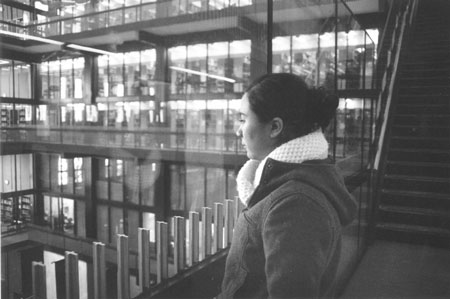By Jessica Mintz
Catie Filkins, a freshman at N.Y.U.’s Steinhardt School, thinks the new Bobst barriers are “really ugly.”
Following the tragic deaths of two students who leapt from the upper balconies of New York University’s Bobst Library in September and October, the school has installed clear, tall barriers along the passages that line the building’s open center atrium, much to the relief of some members of the university community — and to the disappointment of others.
“We began discussion [of the barriers] after the first death, and after the second death we made the announcement that we were moving forward with installation as rapidly as possible,” said John Beckman, vice president of public affairs for the university, in a telephone interview.
The barriers are 8 ft. tall, and are constructed of dark metal frames encasing a clear material called Lexan, which, according to Beckman, is a type of plastic known for its strength and transparency. Construction on the project was completed just after Thanksgiving break, giving students relief from a month-long period of prohibited access to atrium walkways and severely restricted elevator use that left library patrons climbing up and down emergency staircases to navigate the stacks.
Abigail Aronofsky, an undergraduate studying journalism in N.Y.U.’s College of Arts and Sciences, was friends with one of the students whose death prompted the university to add protection to the library’s walkways. “I just mustered up the courage to go there yesterday [Sunday] for the first time since the suicides,” said Aronofsky. “My first thought when I walked in was that I wish the administration had let [the students’] friends place some kind of memorial where they died, maybe a small plaque. It seems wrong to ignore that two students lost their lives there when everyone at N.Y.U. knows.”
A physical memorial “doesn’t seem proper,” said Beckman. “The library, in a research university, is a central resource. It is for a research university a house of knowledge. I am interested in seeing the library’s role as a house of knowledge in our community reasserted, rather than as a place where these terrible deaths took place.”
There is also contention among students and faculty over the aesthetics and the efficacy of the barriers — a response Beckman said was predictable within such a large university.
In spite of her disagreement with the administration over the idea of a memorial, Aronofsky said, “I think the new barriers are entirely appropriate. At first I thought they would be garish and look out of place, but they fit into the balconies pretty nicely. Bobst was short on aesthetic value to begin with, so the barriers don’t damage the ‘library experience’ in any way. If they work to deter just one more suicidal student, then they’re worth it.”
Others aren’t satisfied with the new glossy barricades. “I think they’re really ugly,” said Catie Filkins, a freshman studying secondary education at the Steinhardt School, as she peered through the Lexan. “It’s sad that they have to be here. I guess it was necessary, but it’s sad they had to ruin the entire library because one year, there was a series of bad events.”
Professor Mitchell Stephens, a member of the faculty in the journalism department, said, “It’s a shame that this had to be done. There’s no doubt that [the barriers] limit to some extent the openness and even the look of an interesting building, but certainly I understand why they were put there — and I doubt that N.Y.U. had any choice.”
Outside the library, Alex, who asked that his last name be withheld, took off his headphones to give his more contentious opinion. “It seems futile in that the university is trying to resolve [this] in a way that they will not be held responsible for future actions. Barriers will not prevent people from jumping,” said the senior, who is studying French in the College of Arts and Sciences.
Still, many agree with Beckman that everyone is safer with the Lexan barriers in place.
“I think they should have done it a long time ago,” said Jay Yoon, a senior studying Germanic Literature in the College of Arts and Sciences.
As far as aesthetics, Beckman, a regular library visitor, said, “Visually, [the barriers are] not as prominent as one might have predicted it would be. … The library has a lot of vertical lines in it, long vertical lines, where windows are already in place in the interior atrium.”
And, he said, the barriers were constructed as a quick-response solution to horrible circumstances. “I don’t think people necessarily think this is a long-term solution for the library,” he said.





































